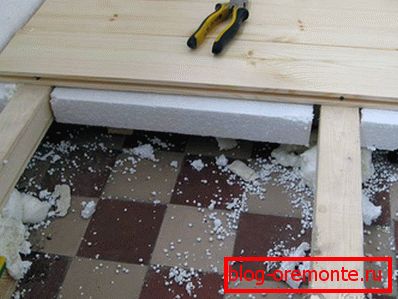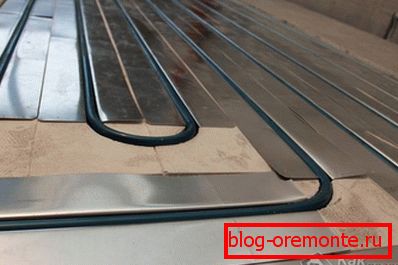How to warm the bathroom floor
If there is another residential floor under the bathroom, then the residents usually do not care how to warm the floor in the bathroom. Another thing, if this room is located on the ground floor, that is, under it there is either a cold basement or in general soil.
How to deal with the feeling of cold

Since it is customary to lay tiles on bathrooms, it can only become warm in one case - if you warm it up from below. The fact is that the tile itself is a cold material, standing on that bare legs you will experience a certain discomfort, like a ceramic tile pulling heat out of you. Therefore, even if you are used to walking around the house barefoot all year round, being on the “bare” floor in the bathroom will not be too pleasant for you.
What materials to use

Besides the fact that the tile does not give you warm sensations, lowering its temperature (below the room level) can be underneath colder materials (if the floor of the house floor is directly on the ground) or unheated rooms (such as the basement).
In these cases, you should take care of additional floor insulation. And since it is necessary to insulate the bathroom floor in such a way that its waterproofing property does not suffer, it is necessary to choose hard, not deformed by the weight of the person, furniture and floor covering. Extruded polystyrene is best suited for this purpose. It has a low density, but it is a plate material that can be used for floor insulation. It should be laid on the vapor barrier to prevent unnecessary ingress of moisture from the ground or from the overlap.

On top of the expanded polystyrene, it is necessary to fill the cement-sand screed with a thickness of at least 5-6 centimeters. At the same time, the screed must be reinforced with a metal mesh to form a monolithic structure. But between the extruded polystyrene foam and screed to put a waterproofing film is not a great need, because this type of insulation does not absorb water in itself and does not swell, and ceramic tile, which will lie on top of the whole structure, does not let water through itself .
Warm floor

But to get a really warm floor, to decide how to warm the floor in the bathroom, it is necessary not only in terms of the use of thermal insulation materials, but also using the same technology. “Warm floors” have long ceased to be exotic, becoming a Russian necessity, especially in areas with cold winters and apartment houses where young children live.
Of course, you can arrange “warm floors” not only in the bathroom, but also in other rooms. But usually it is the bathroom that becomes the first candidate for the role of a room with a heated floor. In addition, the fact that ceramic tiles will lie on the bathroom floor will not cause you any future problems with the thermal deformation of the floor covering, as it is simply not exposed to it.

True, it is not possible for everyone to make a “warm floor” on their own, so it is recommended to contact professionals in this field to do the work. However, to know what the “cake” of this variant of the floor looks like, still follows everyone. So:
- First of all, the surface on which the “warm floor” will be laid must be leveled.
- Then a layer of waterproofing is spread over it (it will not allow moisture to get into the bottom).
- Along the perimeter of the room is placed and fixed damper tape.
- On top of the stack a special material that has cells for fixing pipes. This material immediately plays the role of fixings and heat insulation, which does not allow heat to go down.
- Then the pipes are filled with cement-sand mortar, reinforced with a special mesh.
- On the screed on the tile is laid ceramic tile.
As you can see, the main problem with the device of such a floor is the proper laying of pipes. In a small room you can do it yourself as follows:
- Align the slab with a screed or sprinkle and then tamp the sand.
- Spread polyethylene (it will play the role of vapor barrier).
- Lay extruded polystyrene foam (or simple polystyrene foam with a thickness of at least 2 centimeters) on top.
- Then lay the reinforcement mesh (cell size 100x100 mm, rod thickness 4? 5 mm).
- Roll out and secure (with the help of plastic clamps) a special flexible pipe for “warm floors” so that its beginning and end are near the distribution manifold. Lay the pipe only in those places where you will walk barefoot in the bathroom (for example, it is not necessary to put the pipe under the bath itself or the shower stall). The step between the "turns" of the pipe is usually 25? 30 centimeters.
- In the place where the pipe will exit the concrete screed and connect to the collector, be sure to install protective corners on it.
- Connect the pipes to the collector. Fill the system and check for leaks.
- Fill the screed with a thickness of at least 5 centimeters (but not more than ten).
After it hardens, you can lay ceramic tile on the glue.
Video
Video instructions for installation of electric floor heating: